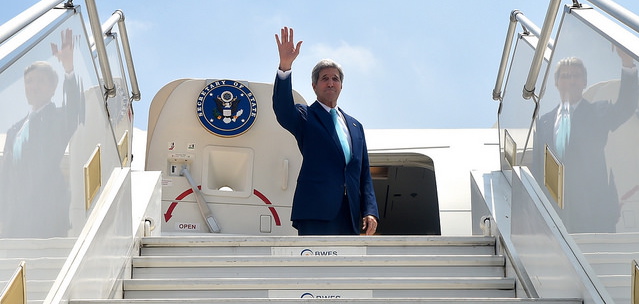Renewed Military Pact Confirms Increased US Interest in India

The affirmation of continued joint India-USA military co-operation by US Secretary of Defence Chuck Hagel in New Delhi is good news for the US military-industrial complex. It also confirms that military modernisation is a priority for New Delhi.
Background
Hagel’s trip to New Delhi resulted in the renewal of the ten-year defence co-operation agreement between India and the US, previously scheduled to lapse in 2015. Hagel’s visit comes after the US Secretary of State, John Kerry, met with Prime Minister Modi a fortnight ago and is partly in preparation for Modi’s trip to Washington in September. The visit also follows two weeks of naval war games involving the USA, Japan and India: the annual Malabar defence exercises.
Comment
At a summit organised by India’s Observer Research Foundation (ORF), Defence Secretary Hagel expressed his administration’s renewed trust in, and admiration for, New Delhi. He declared that India and the US should strengthen their bilateral relationship and move beyond military co-operation, to ‘co-production, co-development and freer exchange of technology’.
Hagel’s speech conjured up images of the sort of military and intelligence partnership that the US usually reserves for other Western countries. He also made it clear that India and the US may not ‘agree on every issue’, but that the US endorses India’s right to forge bonds in its region, just as the US ‘need not choose’ between its Asian alliances and economic interests.
Ever since the US involvement in Afghanistan, US-India ties have escalated considerably. Since the “War on Terror” commenced, India and the US have signed a defence co-operation treaty and India has officially bought more than US$10 billion in military armaments, with Boeing and Lockheed Martin the biggest suppliers. One of the objectives of Hagel visit was to finalise the sale of 39 Apache helicopter gunships and 15 Chinook helicopters, both Boeing technologies, worth an estimated US$1.4 billion.
Immediately prior to Hagel’s visit, the new Indian government passed legislation loosening foreign direct investment (FDI) rules; it raised the foreign ownership limit in military enterprises from 26% to 49%. Among the industries and infrastructure to be opened up to this higher FDI rate are ports and railways, with railways expected to allow up to 100% FDI. The legislation’s finer details disclose an intriguing clause allowing for up to 100% FDI in any project or industry, including military, providing the case is passed by the Cabinet Committee on Security (CCS). In other words, India will accept total foreign ownership if India’s interests are advanced by such an arrangement. This is unusual for a country that previously employed protectionist policies. Perhaps New Delhi’s new-found pragmatism is an answer to China’s partial opening of its markets? New Delhi’s renewed approach to FDI has the potential to paint India as the more attractive of the two countries to multinational investors.
From the American perspective, a new trustworthy client for its defence industry is always a welcome development. The underlying significance in India’s case, is that prior to the fall of communism, Russia supplied India with 75% of its armaments. With a resurgent Russia now a concern to the US and its allies, through the renewal of this defence pact and intensified arms trading, Washington has dealt a small, yet visible, blow to Russia’s prospects of greater influence in the region.
The regional perspective is more nuanced, with US military association and investment being interpreted in New Delhi as a green light for it to be more assertive in its immediate region. The Modi Government has been mindful of Beijing’s influence in Nepal, Bangladesh and Pakistan, not to mention Burma/Myanmar, and, accordingly, has been reaching out to those countries. With the modernisation of its markets and military forces, India is trying to position itself as the most amenable power in the region. Further east, Japan could arguably be said to be mirroring India’s military advancements. This is possibly a key indicator as to why the two governments are keen to further their economic and military ties in the face of China’s increased assertiveness over the contested South China Sea and Senkaku/Diaoyu Islands. Hagel’s announcement further bolsters the US “Pivot to Asia” policy and the resulting agreements could pave the way for a newly articulated Bilateral Investment Treaty with India. From this standpoint, US-India ties are likely to continue to grow.
Ben Pattison is a Research Assistant for the Indian Ocean Research Program.
This article was originally published by Future Directions International. It is republished with permission.


